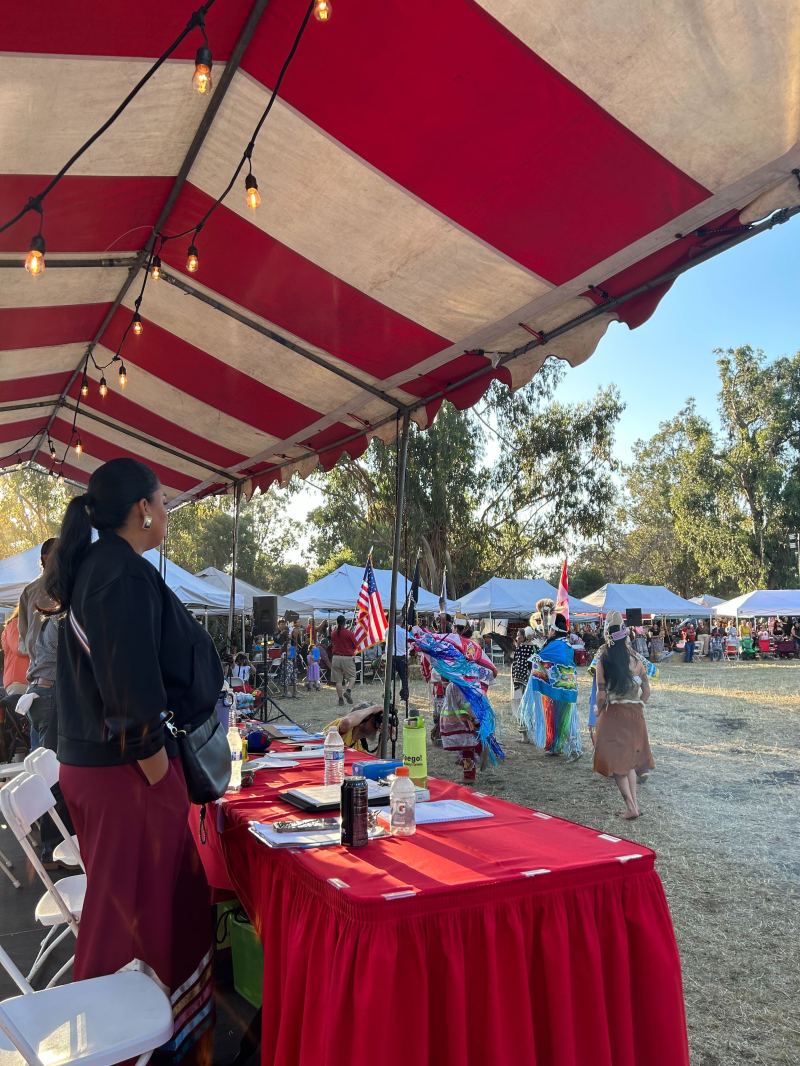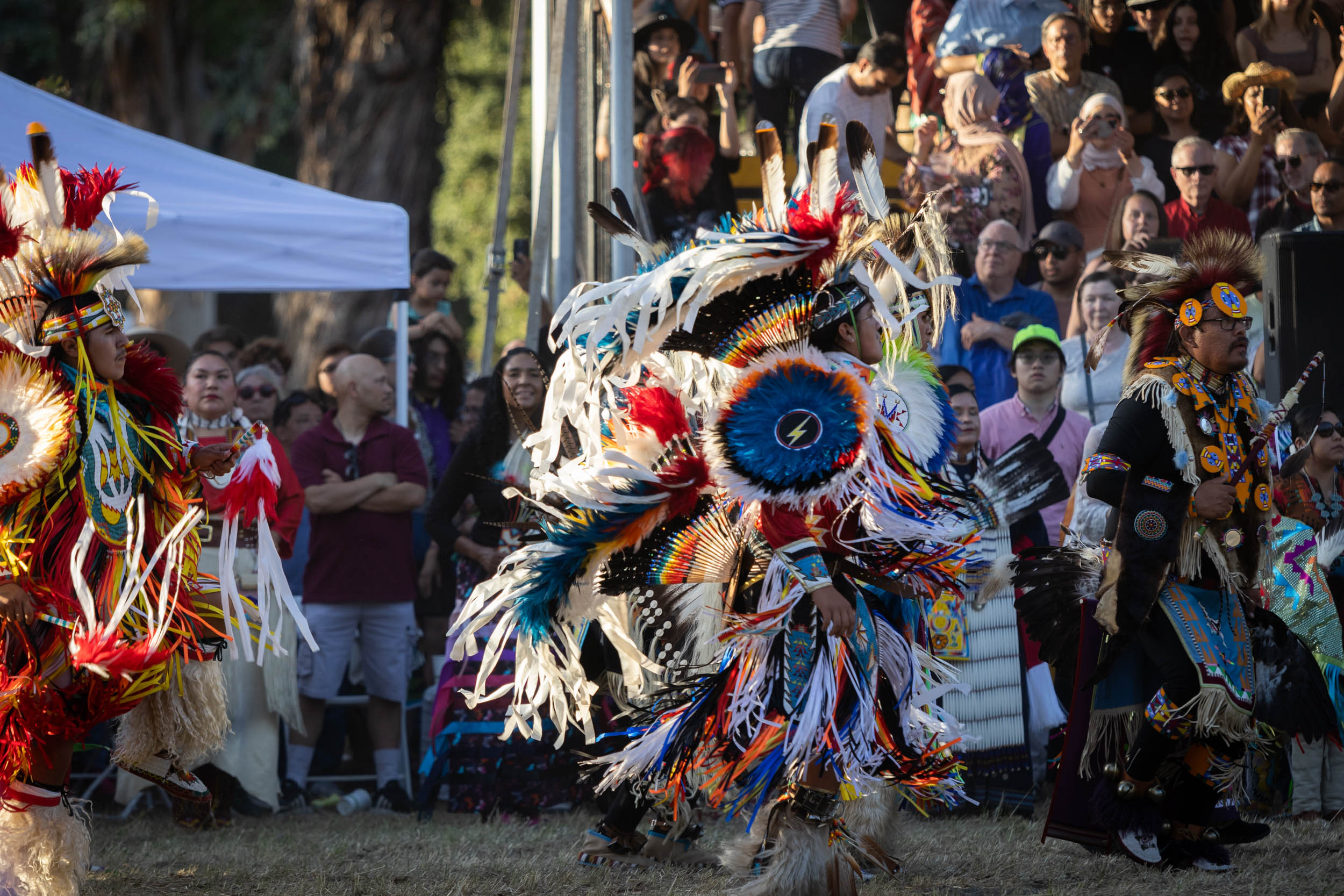Jasmine Kinney ’24 has been making traditional cultural jewelry ever since she could remember. Last weekend, she sold pieces from her own business, Waukela Works, at one of two student-run booths at the 52nd Annual Stanford Powwow, the largest student-run powwow in the country.
“The Powwow really brings people together. That’s something really important for Native students: to be in a community, to bring in our families, to represent ourselves,” Kinney said.
This year’s powwow, themed “Intertribal Unity,” was held from Friday through Sunday at the Eucalyptus Grove on campus. The event drew 30,000 attendees, including students, community members and Indigenous peoples from near and far. Dancers and singers traveled from around North and Central America to participate in the contests, according to Landon Swopes ’24, co-chair of the 2023 Stanford Powwow Committee.
The Grove rejoiced as singers and dancers performed, many with their traditional Indigenous regalia. Crowds watched performances like the smoke dance, which emulated the swirling of smoke through the swift spinning of the dancers. Dance contests brought together dancers from Indigenous and other communities.
Last weekend’s powwow — the second in-person festival since the COVID-19 pandemic — saw increased participation, including an unprecedented number of vendors operating booths. Increased seating was installed around the arena where the dance contests were held to accommodate a larger audience.
“We wanted to make a large splash by bringing the Powwow back to what it was like before the COVID-19 pandemic,” Swopes wrote to The Daily.

The theme of “Intertribal Unity” was showcased throughout the weekend from the vending booths to the Intertribal Dances and the Honor Song for 2023 graduating seniors. The Intertribal Social Dances commenced on Saturday, with the Honor Song inviting Stanford seniors from all tribes to gather at the arena and celebrate their educational milestone among Indigenous community. As part of the final day celebrations on Sunday, dozens of Indigenous women danced in the arena to the commemorative Mother’s Day Honor Song performance.
The myriad vending booths at the powwow featured items from a range of Native American cultures. Small businesses from across North America applied to sell their wares, with the process lasting from Dec. 2022 to Jan. 2023. Applicants went through a “complex vetting process” supervised by Powwow Committee members and Native American Cultural Center staff, according to Swopes. The process aimed to ensure a diverse selection that showcased a variety of Indigenous arts and crafts.
With the performance arena at its center, the edges of Eucalyptus Grove were lined with vending booths offering crafts, jewelry, home decorations and clothing with traditional and contemporary cultural influences. Attendees could be heard commenting on the intricacy of the products being showcased as they made their way through the rows.
Kinney was proud to display her traditional crafts — a sentiment echoed by other small-business owners at the Powwow.
“The materials that I incorporate within my art show the beauty of my home back up north on the Yurok reservation,” Kinney said. “As a student here at Stanford, my art is an outlet that brings me back home. It allows me to continue traditions.”
Lucinda Paddock, owner of the L. Paddock Arts & Crafts booth, expressed the importance of crafts to her community in the Navajo Nation in Cameron, Arizona. She explained that the booth’s wares used materials significant to Navajo culture, such as the sterling silver and turquoise in their jewelry.
“Some people that make the jewelry — my family and friends — are not able to travel,” Paddock said. To compensate for this absence, she and her co-workers have sold their relatives’ jewelry at the Powwow for the past 15 years.
Justice for Muwekma, a year-old Stanford student activist group, also worked a booth at the Powwow. Run by several students from Palo Alto High School, the stand operated a postcard campaign in support of the Ohlone people’s journey to restore their federal status. According to Ella Bishop, a junior at the Palo Alto High School, the organization aimed to educate the community on the issue and lobby for local congressional action.
Bishop and her classmates partnered with Justice for Muwekma as the capstone project for their history course, which encouraged them to take a deep dive into issues relating to the Indigenous people’s struggles. These issues included Missing and Murdered Indigenous Women and the Muwekma Ohlone’s fight for federal recognition. Bishop was gratified by the impact of the partnership.
“It has gone a lot further than any of us expected. I was a part of a delegation that went to DC to lobby for Congress with Justice for Muwekma,” Bishop told The Daily. “It’s been a long journey, and I think it’s going to continue next year.”
The Powwow offered a venue for craftsmen, organizers and attendees alike to celebrate Indigenous culture as a community. Swopes shared his love and gratitude for the 40 members of the Powwow Committee.
“Many of them were strangers in the fall and have become close friends through this event. I feel honored to have witnessed these relationships forming,” Swopes commented.
Jane Lord-Krause ’25, co-head of the Booth Committee and a member of the Mvskoke Creek Nation, said Stanford’s unique Indigenous community was a strong motivation for choosing to attend the university. To Lord-Krause, the Powwow is a crucial “demonstration of the vibrancy of the Native community.”
Landon Swopes ’24 is the student-at-large on The Daily‘s Board of Directors. He is not a member of The Daily.
